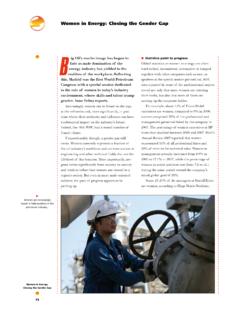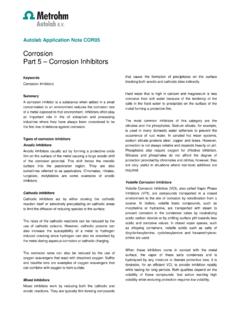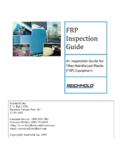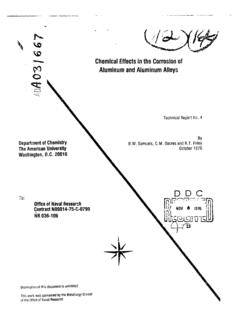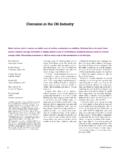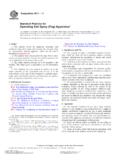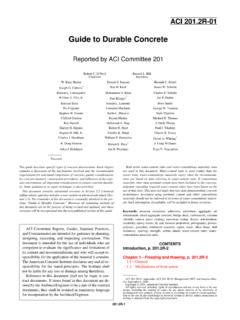Transcription of International Conference - Challenges Faced in High …
1 11 Challenges in Opportunity Crude Processing16thApril 2012 Thomas LuIndustry Development Manager Asia PacificOverview Opportunity Crude Trends (High TAN Crude) and its Challenges Overview of Factors Affecting corrosion Prevention Methods High Temperature corrosion Control Summary2 Opportunity Crude Trends Declining conventional oil production Opportunity crude oil production forecast to grow up to 20% by 2025 Extra Heavy (< 22o API) as part of crude slates (average globally)Fundamentals Historic Perspective Problem since 1920s Systematic study since 1950s Chevron published correlation in 1980s Nalco first Scorpion program in 1984 Nalco published Sulfidiccorrosion phenomenon in 2005 Review of 25 years of Scorpion program published in 200643 What are High Acid Crudes Crudes with a TAN of or higher 5 RCH2mC - OHnOR = Alkyl Groups COOH = Carboxylic Acid CH2= Alkyl chainFundamentals Measurement TAN = Total Acid Number Two common ASTM methods.
2 - D974 (colorimetric- older, used for distillates)- D664 (potentiometric- more accurate but measures acid gases, in addition to organic acids)- Differences important on crudes, less significant on distillates) UOP 565 / UOP 587 more applicable Nalco NAT64 Will it Cause corrosion ? Majority of the challenge crudes on the market are high acid crudes Total acidity Naphthenic acid content Distribution of acids Other species include organic acids, organic chlorides, undesaltablechlorides, amines, etc. Not all TAN is a problem Measure of naphthenic acid content better gauge of corrosivityHigh Temperature Naphthenic Acid Corrosion5 Distribution can be used to determine likely areas of concern Some newer assays have this TAN data Nalco has a library of high acid crude nap acid distributions- Relative comparison with respect to field experienceDistribution of AcidCorrosivity Testing Laboratory apparatus used to simulate temperature and shear stress Test metallurgy of the unit Test inhibitor
3 Effectiveness024681012141618 corrosion Rate, MPYCS5Cr9Cr410 SSTest SampleUntreatedTreated6 Factors Affecting corrosion Vulnerable Locations for HAC Preventative Methods Other Impacts11 Examples: Vacuum Unit 12 Severe corrosion on an Outer Bend of an Elbow Just Upstream from the Collection Header7 Examples: Vacuum Bubble Cap Corrosion13 Severe pitting corrosion of Type 410 Stainless Bubble Cap from a Resid Stripper ColumnAnother View of the Corroded Bubble CapExamples: 5 Cr - 1/2 Mo Check Valve in HVGO in Crude Unit148 Factors Effecting corrosion Temperature Naphthenic acids concentrate above 450 F (232 C) boiling range Highest concentration in 600-800 F (316-427 C) boiling range Lowest temperature where attack occurs ~400 F (200 C) Lower molecular acids at water condensing locations: HCOOH ; (CH3)n-COOH15 Factors Effecting corrosion cont.
4 Velocity At low velocity, turbulence caused by boiling and condensing causes attack At high velocity, rapid corrosion can occur Limits well defined for conventional crudes169 Naphthenic Acid corrosion of Carbon Steel17150302200250300350010203040200390 250480300570350660 Temperature, oC (oF) corrosion Rate of Carbon Steel at - TANI nfluence of Linear Velocity on corrosion Rates in Crude Oil18 MaterialTANL inear Velocity,(ft/sec) corrosion Rates at elbows (mm/yr) Rates of Some Alloy Steels During 7 Month Coupon Exposure in a Crude Unit19 TemperatureoC (oF)Acid (710)3+48+ (648) + (640) + (570) * corrosion rates shown are MPY.
5 Data from literatureNaphthenic Acids - Distillation profile20 Profiles available for many crudes01002003004005006007008000%10%20%3 0%40%50%60%70%80%90%100%Volume PercentTemp (deg C)Cerro Negro (Venezuela)DOBAG raneDARP eregrinoPetroAndinaAlbacora11 Prevention Methods Blending Typically , blend high TAN with low TAN crude Blending primarily based on desired product mix Metallurgy can become limiting Crude compatibility needs evaluation Sulfur in blend crude may be critical Materials Upgrade In mild service, 9 Cr - 1 Mo sometimes adequate Usually 316L (2% Mo) minimum material 317L (3% Mo) often used Structured packing requires 317L min.
6 When chloride stress corrosion cracking (CISCC) is a potential problem, 2205 or 2507 have been used When high corrosion and/or CISCC are a problem, I625 has been used21 Prevention Methods cont Use of Inhibitors Continuous use of high acid crudes (HAC)- Successful applications exist for wide range of TAN and NAT- Important to maintain monitoring in areas at risk- Can be continuous or (depending upon strategy) until metallurgy is upgraded. Intermittent use of HAC- Used when corrosion rates are excessive based on monitoring Cost directly related to amount of equipment protected2212 High Temperature corrosion ControlSCORPION High TemperatureCorrosion Control 25+ Years of Experience >130 HAC Assessments Globally Innovative Monitoring (FSM) Most Comprehensive ChemistriesBest Practice in KM (KM, Downstream, Our Brands, click on SCORPION logo)Step 1.
7 Assessment Risk Assessment13 Unit /RiskSystemDescriptionAssessmentLine from mix5 to split6 ModerateLine from split6 to furnace 302B control valve to Furnace control valveLowFurnace linesModerateLine from furnace colector to mix 6 HighLine from split6 to mix6 (by-pass) to &101 BLine from mix6 to split7 ModerateLine from split7 to furnace 101B manifold valveModerateManifold lines (inlets 101B)Low101B Furnace lines convective areaModerate101B Furnace lines radiation areaModerateLines from furnace 101B colector to from to mix7 LowLine from split7 to furnace 151B manifold valveModerateManifold lines (inlets 151B)
8 Moderate151B Furnace lines convective area Moderate151B Furnace lines radiation area LowLines from furnace 151B colector to from to mix7 HighExample of Risk AssessmentExample of Risk AssessmentRisk AssessmentHigh Acid Crude Assessment OutputSCORPION Inhibitor Injection LocationCorrosion Probe Monitoring LocationCPIP718To DCU/Tk F385oF597oFVaporICSCSOverFlash650-700oF9 Cr5Cr600-650oFQuenchFlash Zone750oF750-760oF316L SSIFeedSurgeDrum(5Cr) ChargeHeaterFuel Gas/Distillateto Vacuum Nalco Scorpion Applications0123456781% of Applications > 63% of Applications > 422% of Applications > 333% of Applications > 259% of Applications > 185% of Applications > Does SCORPION Work?
9 Inhibitors work by forming an extremely tenacious and persistent passive surface Currently there are three types of SCORPION inhibitors supplied by Nalco Phosphorous-based Sulphur-based Phosphorous and Sulphurbased Nalco possessed patents on Phosphate ester chemistry, and possesses patents on Sulphur and combination Long Does the Film Persist? Example shown: >14 days A lot less for a transfer line Depends on velocity and turbulence C orro sion Rate a nd % HAC Crude0123456789103-Mar8-Mar13-Mar18-Mar2 3-Mar28-Mar2-Apr7-Apr12-Apr17-Apr22-Apr2 7-Apr2-May7-May12-May17-May22-May27-May1 -Jun6-Jun11-Jun16-Jun21-Jun26-Jun1-Jul6- Jul11-Jul16-JulDateCorrosion Rate (mpy)0102030405060% HAC Crude / Inhibitor (ppm)Corro sion RateIn hibito r (E C1245A)% HAC CrudeImpact of InhibitorUntreatedTreatedUntreatedTreate d410SS9 Chrome5 ChromeCarbon (mm/yr)
10 DOBA Corrosivity Testing410SS9 Chrome5 ChromeCarbon SteelLVGO CUT370-425 CHVGO CUT510-555 CInhibitor Comparative Performance w/Various Crudes1631 Naphthenic Acids other impacts Impact on Tank Farm Poor water removal Emulsion formation in tankage Impact on Desalter Emulsion in desalter Oil undercarry Water carryover Tank Farm Solutions Tank mixers Crude blending Tankage dehydration additives DesalterSolutions Increase wash water Increase temperature Increase mixing DemulsifierselectionSummary Processing opportunity crudes ( High TAN) can significa



